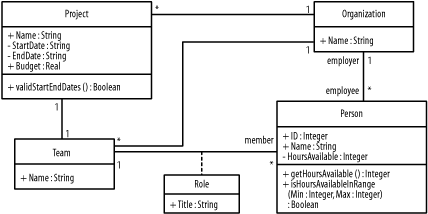|
|
|
10.1 ExpressionsAs discussed in Chapter 9, a property is a characteristic of a model element shown as part of a comma-delimited list of text strings inside a pair of braces ({}) after or below the name of a model element, and a constraint is a rule for a model element shown as a text string within the property list. An OCL expression is a constraint that yields a value when evaluated. An invariant is an expression attached to a model element that must hold true for all instances of that model element. That is, an expression attached to a class means that each object of the class must satisfy the expression, and an expression attached to an association means that each link of the association must satisfy the expression. When an expression is evaluated for a specific object or link, the object or link is known as the contextual instance, and the optional keyword self in an expression refers to that contextual instance. An OCL expression is evaluated from left to right. For an expression attached to an object, the expression may reference its attributes and tags, side effect-free operations, links and link objects, and the objects with which it is linked through the link ends of its links. For an expression attached to a link, the expression may reference its attributes and tags, side effect-free operations, and the objects it links through its link ends. A side effect-free operation is an operation that does not modify the attributes of an object or link, but may calculate and return a value. As each part of an expression is evaluated, each intermediate resulting value may be a single object or a collection of objects called a collection that is further used in the evaluation of the overall expression. Expressions may involve integers and real numbers, strings, and other objects defined in a model. For integers and real numbers, you can use the arithmetic operators and comparison operators shown in Table 10-1. For strings, you can use the = operator for "equal to" and the <> operator for "not equal to." In addition, expressions may use the logical operators, also shown in Table 10-1. As an expression is evaluated from left to right, the unary operators have the highest precedence, followed by the arithmetic operators, and then followed by the logical operators. These operations are used in the OCL much the way they are used in Java, C++, C#, or any other similar programming language with which you may be familiar.
Figure 10-1 shows various relationships among organizations, projects, teams, people, and people's roles on teams in the project management system. An organization relates to zero or more projects, zero or more teams, and zero or more people who are employees of the organization. A project relates to a single organization and to a single team. A team relates to a single organization and to a single project. A person relates to a single organization that is an employer. A team relates to zero or more people as members of the team in which a person plays a role. A person relates to a single team in which the person plays a role. Figure 10-1. Organizations, projects, teams, and people Figure 10-1 also shows various details about organizations, projects, teams, people, and people's roles on teams in the project management system. A project has a name that is a string, a start date that is a string, an end date that is a string, a budget that is a real number, and an operation to ensure that the start date and end date of the project are valid (that the project's start date precedes its end date). Each team and organization has a name that is a string. A person has an identification number that is an integer, a name that is a string, hours that they are available to work presented as an integer, an operation to retrieve the number of hours that they are available to work, and an operation to determine whether the number of hours that they are available to work is within a range of a minimum and maximum number of hours. The relationship between a person and a team defines the title as a string of the role that the person plays on the team. All the attributes and operations are public, but a project's start and end date and the hours they are available to work are private. I'll use Figure 10-1 throughout the remainder of this chapter as the basis for showing you how to apply the OCL. |
|
|
|